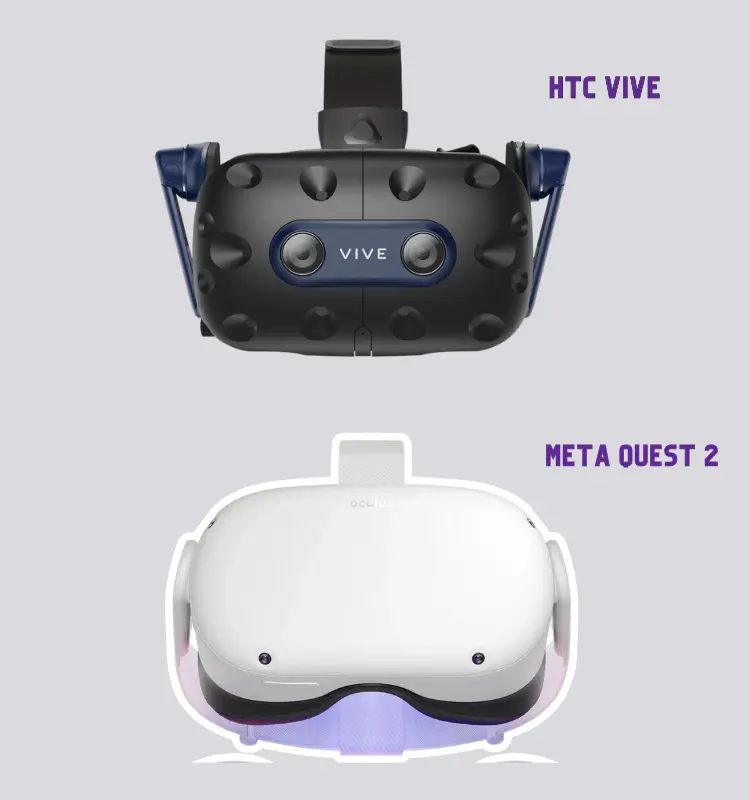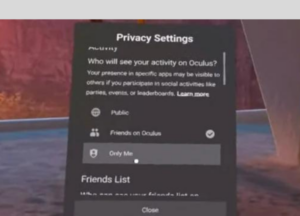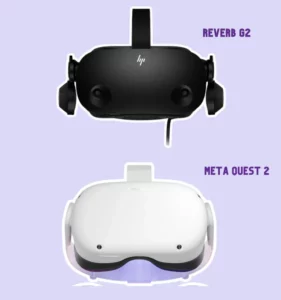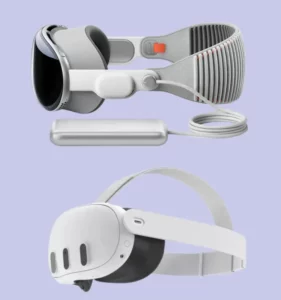Not everyone needs or wants a virtual reality headset, but if you’re looking into getting one, you’ve definitely thought about either the Meta Quest 2 or the HTC Vive Pro 2. But how do you know which one is best? Even though they both accomplish the same thing, they are distinctive in their own ways.
Comparison Table: HTC Vive Pro 2 s Meta Quest 2
| HTC Vive Pro 2 | Oculus Quest 2 | |
| What it is: | Tethered VR Headset | Standalone VR headset |
| Primary Use: | VR Games, Spatial Computing, Remote Work, and 3D experiences | VR Games, Spatial Computing, Remote Work, and 3D experiences |
| Initial Release: | May 11, 2021 | October 13, 2020 |
| Technical Committee: | HTC | Meta/Facebook/Oculus |
| Influential Developers: | HTC | Meta/Facebook/Oculus |
| Open Format: | No | No, but it is modular |
| Technologies Influenced: | Gaming, VR GPUs, spatial computing, metaverse | gaming, Apple VR, Spectacles, modeling applications, remote work, spatial computing |
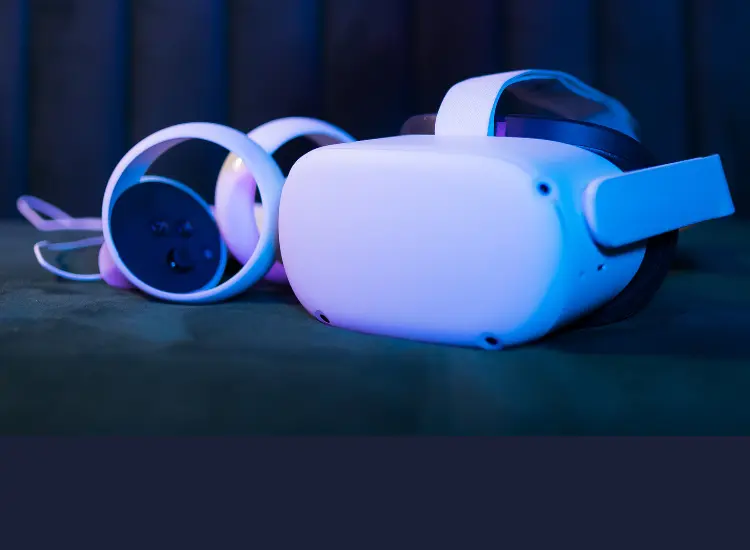

A Contrast Between the Meta Quest 2 and The HTC Vive Pro 2
I know at first glance these two headphones look very different from one another, but I assure you that is not the case. The virtual reality market is still rather niche no matter how you cut it. Virtual reality (VR) is a growing subgenre of video games that transports players into a computer-generated world where they may interact with virtual objects and other players.
Outside of the gaming business, virtual reality’s (VR) current applications are limited. Considering how simple it is to conduct a video call, the practicality of using VR for teleconferences is questionable. Therefore, only businesses requiring total user immersion, such as architecture, may make commercial use of VR at this time.
The intended markets for virtual reality (VR) headsets like the Meta Quest 2, HTC Vive Pro 2, and similar products are not metaverse purists, but rather gamers and specialized businesses.
But which do you think would work best for you?
So, let’s work this out together.
The HTC Vive Pro 2 can render at 5K resolution on an LCD panel, which is a significant improvement over the Meta Quest 2. The Meta Quest 2 has a maximum resolution of 1080p, but that display is an OLED screen, which can provide far more realistic blacks.
Having tried both, I can say that the Vive’s headset is noticeably superior in terms of overall quality, but I never found it to be a deal breaker when playing games. I didn’t care if the framerate was 90 or 120 hertz; as long as it seemed natural, I was good with either headset.
Read! Meta Quest 2 Vs Reverb G2 VR
Performance
In order to play games in their native resolution and frame rate on the HTC Vive Pro 2, a more powerful PC is required.
When I tested both headsets on F1 2022 in SteamVR, I discovered that the Meta Quest 2 offered a more stable framerate and let me crank up the graphics settings more so than the HTC Vive Pro 2.
Now is also a good time to bring up the fact that the Meta Quest 2 can operate completely independently. If you don’t want to connect your headset to a PC, there is a decent selection of games available, albeit they are all exclusive to the Oculus Store (of which F1 2022 isn’t a part). Bear in mind, though, that these titles are often less robust than what you’d get on Steam.
Tracking Ability
In order to translate your movements and the actions of your hands (via the controllers), the HTC Vive Pro 2 employs tracking base stations (also known as “lighthouses”). The optimal placement for these beacons is high above you at an incline in a large room, on opposite walls.
Careful preparation is required, as is the provision of a special virtual reality gaming area. However, there are portable stands available if you don’t want to make permanent adjustments to your walls like I do as a tenant.
The Meta Quest 2 is preferable if you’re looking for a straightforward answer because it doesn’t require external beacons for tracking. As a result, you can pack less along on your trip if you plan to bring the headset with you.
Read! Meta Quest Pro Vs Pico 4
Access to Computers
Unless you’re using the Meta Quest 2, all headsets require a personal computer in order to take advantage of the full capabilities of the PC’s hardware and software.
In order to achieve this, you will need to connect the HTC Vive Pro 2 to a graphics card with a Display Port (much like you would attach a monitor). The Meta Quest 2 ships with a charging cable but not a specialized streaming wire; however, Meta sells the latter for $125. This plugs into your computer’s USB-C 3.1 port.
While wireless connectivity isn’t required for virtual reality headsets, I’d recommend it if you want the most immersive experience possible.
The Meta Quest 2 has built-in “Air Link” connectivity, letting you easily connect to your PC over a LAN connection so long as your modem-router can handle it.
Other Insights
If you’re willing to spend $599 on a wireless adapter, the HTC Vive Pro 2 can do the same thing. In addition, your motherboard must have a spare PCIE slot.
While the HTC Vive Pro 2 is noticeably heavier than the Meta Quest 2, it also seems more robust because to its sturdy plastics and comfortable head strap. Both headsets have built-in sound systems and mics; I couldn’t tell much of a difference when using them.
The Vive Pro 2 and its controllers feel more sturdy and well-made than the Meta Quest 2 does. They’re sturdier and more difficult to crack than I expected.
While the Meta Quest 2 controllers require AA batteries, the Vive Pro 2 controllers may be recharged with a USB-C cable. While both hands can utilize the same HTC Vive Pro 2 controller, the Meta Quest 2 controllers are designed specifically for the left and right hands.
A few people, especially those looking for a successor, could care about this little detail.
For analog movement, the Vive Pro 2 controllers have touchpads, whereas the Meta Quest 2 controllers rely on joysticks. While the joysticks are my go-to for virtual reality controls, I found that the touchpads on the Vive Pro 2 controllers were responsive and easy to use.
The HTC Vive Pro 2 controller (left) and the Meta Quest 2 controller (right). Photographed by Zachariah Kelly/Gizmodo Australia
Read! Apple Vision Pro vs. Meta Quest Pro
Is the Quest 2 compatible with the Vive?
Nope. The HTC Vive Pro 2 and the Meta Quest 2 are two separate virtual reality systems that use incompatible platforms, components, and software. The controllers, despite sharing a similar design philosophy with both headsets, use different tracking technologies.
Both the HTC Vive Pro 2 and the Meta Quest 2 are compatible with PCs that are capable of running SteamVR titles, so there’s good news there.
When contrasted to the HTC Vive Pro 2, which retails for $2,199 plus a $599 wireless adapter, the Meta Quest 2’s $630 (plus $125 for the PC link cable) price tag seems downright reasonable.
Is it preferable to use the HTC Vive Pro 2 or the Meta Quest 2?
Compared to the HTC Vive Pro 2, the Meta Quest 2 is arguably the best value.
The Meta Quest 2 is more capable and portable than the HTC Vive Pro 2, and its price is more than three times lower. It also includes internal tracking and access to internal games, which makes you wonder how demanding your needs would be if you were to select the more expensive option.
The Vive Pro 2 is a good option if enhanced visuals are a priority, but you should give some thought to how crucial this is before making a purchase.
HTC’s suggested retail price for the Vive Pro 2 is $2,199. On Amazon, you can purchase the Meta Quest 2 for $630.
Read! Apple Vision Pro vs Quest 3
Which virtual reality headset is better on Black Friday, the Oculus Quest 2 or the HTC Vive Pro 2?
Your answer to this question should reflect the things you care most about. If you want to have some cheap fun in VR or test out some more compact, focused experiences, the Oculus Quest 2 is a fantastic choice.
Although it is still costly, it is less so than competing options and offers comparable sophistication in terms of technology. With its high resolution, large catalog of games (including the fantastic Star Wars: Vader Immortal), and “out of the box” playability, it is the simplest way to delve into virtual reality (VR). When linked to a PC, it enables access to Steam games. However, not everyone benefits from using IPD lenses with a mechanical adjustment. In addition, the PC connection is confusing.
On the opposite end of the scale is HTC’s new Vive Pro headset, which is a virtual reality (VR) PC gamer’s paradise. Even if the price tag is out the roof, it’s undeniably one of the most spectacular virtual reality (VR) experiences you can have.
You can expect a far more immersive (5K!) experience due to the utilization of dedicated motion trackers and top-tier computer hardware. Because of this, it’s perfect for gamers who wish to immerse themselves fully in the virtual world. The fact that you can play Oculus games with third-party software means you get the best of both worlds.
The Pro 2 will burn a hole in your wallet, unfortunately. The bulky wire connecting you to your computer is a drawback, as is the requirement of an i5 or AMD Ryzen 1500 processor and a GeForce RTX 20 Series or AMD Radeon 5000 graphics card.
Final Words
If you are new to virtual reality, I recommend trying out the Oculus Quest 2. Which one should you spend your money on? Here’s the lowdown: if you’re curious about virtual reality but aren’t sure how much use you’ll get out of it over the long haul, I think you’d benefit from trying out the Oculus Quest 2. However, the Vive Pro 2 is the better choice if you want to experience the full potential of the medium without having to worry about upgrading your equipment again in a few years. Yes, it costs more, but it serves many more purposes than its less expensive counterparts. In terms of virtual reality quality, it’s hard to beat.
Read Related: Meta Quest 3 Vs Vive XR Elite
